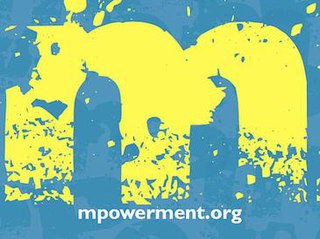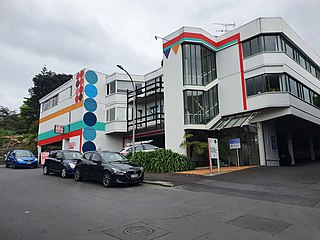Related Research Articles

Safe sex is sexual activity using methods or contraceptive devices to reduce the risk of transmitting or acquiring sexually transmitted infections (STIs), especially HIV. "Safe sex" is also sometimes referred to as safer sex or protected sex to indicate that some safe sex practices do not eliminate STI risks. It is also sometimes used colloquially to describe methods aimed at preventing pregnancy that may or may not also lower STI risks.

The AIDS epidemic, caused by HIV, found its way to the United States between the 1970s and 1980s, but was first noticed after doctors discovered clusters of Kaposi's sarcoma and pneumocystis pneumonia in homosexual men in Los Angeles, New York City, and San Francisco in 1981. Treatment of HIV/AIDS is primarily via the use of multiple antiretroviral drugs, and education programs to help people avoid infection.
Men who have sex with men (MSM) refers to all men who engage in sexual activity with other men, regardless of sexual identity. The term was created by epidemiologists in the 1990s, to better study and communicate the spread of sexually transmitted infections such as HIV/AIDS between all sexually active males, not strictly those identifying as gay or bisexual, but also for example male prostitutes. The term is often used in medical literature and social research to describe such men as a group. It does not describe any specific kind of sexual activity, and which activities are covered by the term depends on context. An alternative term, males who have sex with males is sometimes considered more accurate in cases where those described may not be legal adults.

Bareback sex is physical sexual activity, especially sexual penetration, without the use of a condom. The topic primarily concerns anal sex between men without the use of a condom, and may be distinguished from unprotected sex because bareback sex denotes the deliberate act of forgoing condom use.
Condom fatigue is a term used by medical professionals and safer sex educators to refer to the phenomenon of decreased condom use. It is related to decreased effectiveness of safer sex messages because people who realize the necessity of condoms still perpetuate the phenomenon. It is typically expressed as a frustration with the idea of a future filled with less sexual pleasure due to the use of condoms.
The Caribbean is the second-most affected region in the world in terms of HIV prevalence rates. Based on 2009 data, about 1.0 percent of the adult population is living with the disease, which is higher than any other region except Sub-Saharan Africa. Several factors influence this epidemic, including poverty, gender, sex tourism, and stigma. HIV incidence in the Caribbean declined 49% between 2001 and 2012. Different countries have employed a variety of responses to the disease, with a range of challenges and successes.

Sexual Ecology: AIDS and the Destiny of Gay Men is a 1997 book by gay activist Gabriel Rotello, who discusses why HIV has continued to infect large numbers of gay men despite the widespread use of condoms and why a number of experts believe that new HIV infections will disproportionately affect gay men in the future. Rotello examines the origins and timeline of the AIDS epidemic, drawing on epidemiology, sociology, gay history, and ecology. His conclusion is that gay men need to reduce their number of partners and increase condom use to bring the infection rate down. Rotello's central argument derives from the epidemiological concept that sexually-transmitted epidemics are the result of three factors, sometimes called the Triad of Risk: the "infectivity" of a sexually transmitted disease (STD), or how easily it spreads; the "prevalence" of that STD in a particular group, and 3. the ‘contact rate,’ or the average number of sexual partners that people have within a particular group.

The Mpowerment Project is a model community building and HIV prevention program that has been designed specifically to address the needs of young adult gay/bisexual men ages 18 – 29. It is the first documented HIV prevention intervention for young gay/bisexual men to succeed in reducing sexual risk behavior. The program has been developed, evaluated and continually refined by prominent behavioral scientists from the University of California, San Francisco's Center for AIDS Prevention Studies, the largest research center in the world dedicated to social, behavioral and policy science approaches to HIV.

Rwanda faces a generalized epidemic, with an HIV prevalence rate of 3.1 percent among adults ages 15 to 49. The prevalence rate has remained relatively stable, with an overall decline since the late 1990s, partly due to improved HIV surveillance methodology. In general, HIV prevalence is higher in urban areas than in rural areas, and women are at higher risk of HIV infection than men. Young women ages 15 to 24 are twice as likely to be infected with HIV as young men in the same age group. Populations at higher risk of HIV infection include people in prostitution and men attending clinics for sexually transmitted infections.
Since HIV/AIDS was first reported in Thailand in 1984, 1,115,415 adults had been infected as of 2008, with 585,830 having died since 1984. 532,522 Thais were living with HIV/AIDS in 2008. In 2009 the adult prevalence of HIV was 1.3%. As of 2016, Thailand had the highest prevalence of HIV in Southeast Asia at 1.1 percent, the 40th highest prevalence of 109 nations.
The Dominican Republic has a 0.7 percent prevalence rate of HIV/AIDS, among the lowest percentage-wise in the Caribbean region. However, it has the second most cases in the Caribbean region in total, with an estimated 46,000 HIV/AIDS-positive Dominicans as of 2013.
Honduras is the Central American country most adversely affected by the HIV/AIDS epidemic. It is estimated that the prevalence of HIV among Honduran adults is 1.5%.
Sexually transmitted infections in the pornography industry deals with the occupational safety and health hazard of contracting sexually transmitted infections (STIs) by workers in the sex industry. Since the 1980s many cases of pornographic performers contracting HIV/AIDS have been reported. However, since the mid-2000s strict adherence to rigorous STI testing, and limiting sexual contact with only fellow tested performers has halted the spread of HIV and other STIs in the industry.
The Naz Foundation (India) Trust is a non-governmental organisation (NGO) in that country that works on HIV/AIDS and sexual health. It is based in the Indian capital of New Delhi.

The affected community is composed of people who are living with HIV and AIDS, plus individuals whose lives are directly influenced by HIV infection. This originally was defined as young to middle aged adults who associate with being gay or bisexual men, and or injection drug users. HIV-affected community is a community that is affected directly or indirectly affected by HIV. These communities are usually influenced by HIV and undertake risky behaviours that lead to a higher chance of HIV infection. To date HIV infection is still one of the leading cause of deaths around the world with an estimate of 36.8 million people diagnosed with HIV by the end of 2017, but there can particular communities that are more vulnerable to HIV infection, these communities include certain races, gender, minorities, and disadvantaged communities. One of the most common communities at risk is the gay community as it is commonly transmitted through unsafe sex. The main factor that contributes to HIV infection within the gay/bisexual community is that gay men do not use protection when performing anal sex or other sexual activities which can lead to a higher risk of HIV infections. Another community will be people diagnosed with mental health issues, such as depression is one of the most common related mental illnesses associated with HIV infection. HIV testing is an essential role in reducing HIV infection within communities as it can lead to prevention and treatment of HIV infections but also helps with early diagnosis of HIV. Educating young people in a community with the knowledge of HIV prevention will be able to help decrease the prevalence within the community. As education is an important source for development in many areas. Research has shown that people more at risk for HIV are part of disenfranchised and inner city populations as drug use and sexually transmitted diseases(STDs) are more prevalent. People with mental illnesses that inhibit making decisions or overlook sexual tendencies are especially at risk for contracting HIV.

The Burnett Foundation Aotearoa is New Zealand’s national HIV prevention and healthcare organisation. Its funding is derived from grants, donations and the Ministry of Health.
HIV prevention refers to practices that aim to prevent the spread of the human immunodeficiency virus (HIV). HIV prevention practices may be undertaken by individuals to protect their own health and the health of those in their community, or may be instituted by governments and community-based organizations as public health policies.

How to Have Sex in an Epidemic: One Approach is a 1983 manual by Richard Berkowitz and Michael Callen, under the direction of Joseph Sonnabend, to advise men who have sex with men (MSM) about how to avoid contracting the infecting agent which causes AIDS. It was among the first publications to recommend the use of condoms to prevent the transmission of STDs in men having sex with men, and has even been named, along with Play Fair!, as one of the foundational publications in the advent of modern safe sex.
Since reports of emergence and spread of the human immunodeficiency virus (HIV) in the United States between the 1970s and 1980s, the HIV/AIDS epidemic has frequently been linked to gay, bisexual, and other men who have sex with men (MSM) by epidemiologists and medical professionals. It was first noticed after doctors discovered clusters of Kaposi's sarcoma and pneumocystis pneumonia in homosexual men in Los Angeles, New York City, and San Francisco in 1981. The first official report on the virus was published by the Center for Disease Control (CDC) on June 5, 1981, and detailed the cases of five young gay men who were hospitalized with serious infections. A month later, The New York Times reported that 41 homosexuals had been diagnosed with Kaposi's sarcoma, and eight had died less than 24 months after the diagnosis was made.

In the late 1980s, the African Research and Educational Puppetry Program (AREPP) founded "Puppets Against AIDS", a traveling puppet show that visited African villages and cities to encourage audience members to use condoms to prevent HIV/AIDS transmission.
References
- ↑ Langenberg, Sara (July 28, 1988). ""Dorothy learns of safe sex from the 'Wizard of AIDS' "" (PDF). The Daily Iowan. p. 1.
- ↑ "'Wizard of AIDS' play stresses safe-sex theme". The Milwaukee Sentinel. 1987-05-20. p. 8. Retrieved 2009-08-26.
- ↑ Van Buren, Abigail (1992-03-11). "Education is first defense against the spread of AIDS". Dear Abby. Retrieved 2009-08-26.
- ↑ "Falls board will allow play on AIDS". The Milwaukee Sentinel. 1992-01-28. p. 4A. Retrieved 2009-08-26.
- ↑ Krentz, Gary (1991-12-13). "AIDS play at school postponed". The Milwaukee Sentinel. p. 1. Retrieved 2009-08-26.